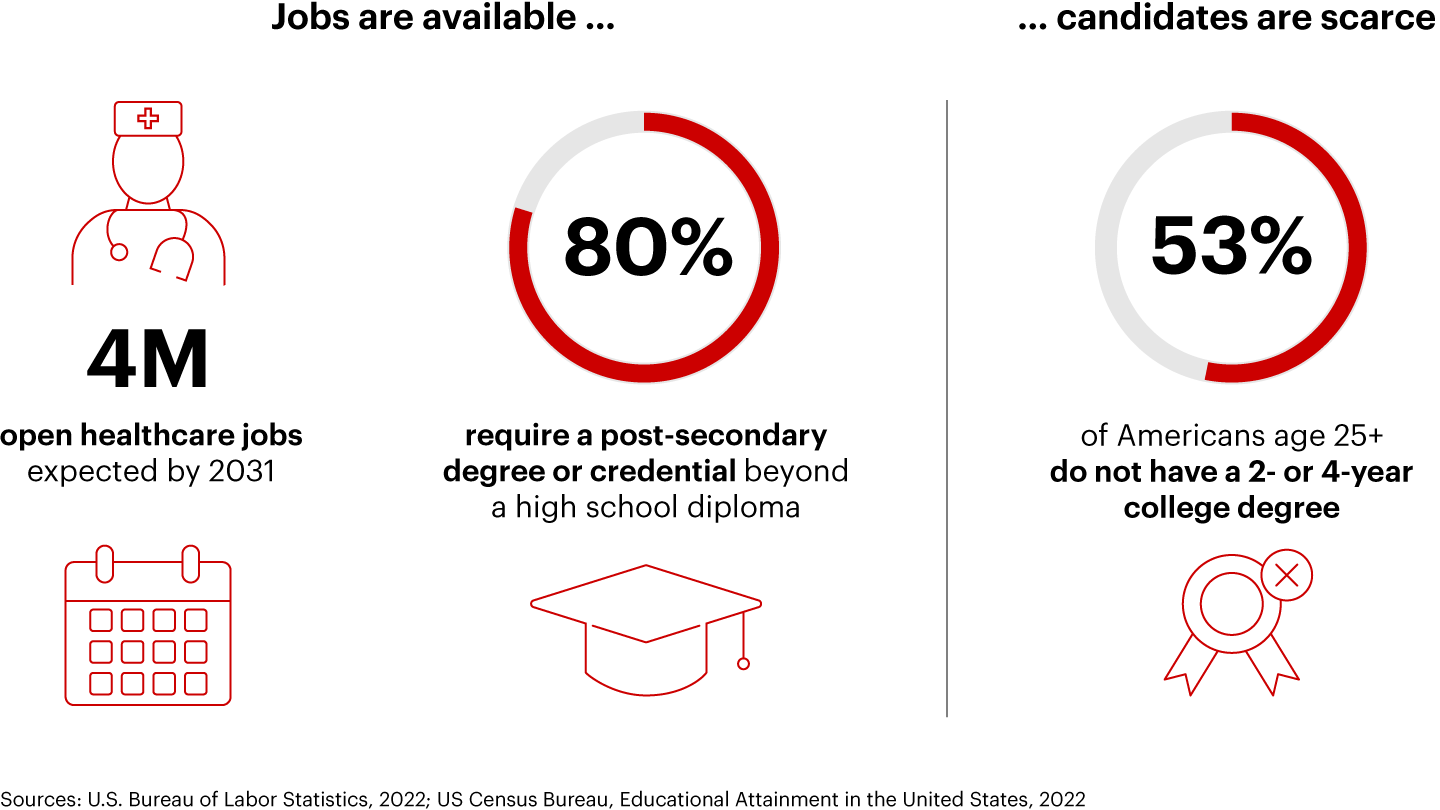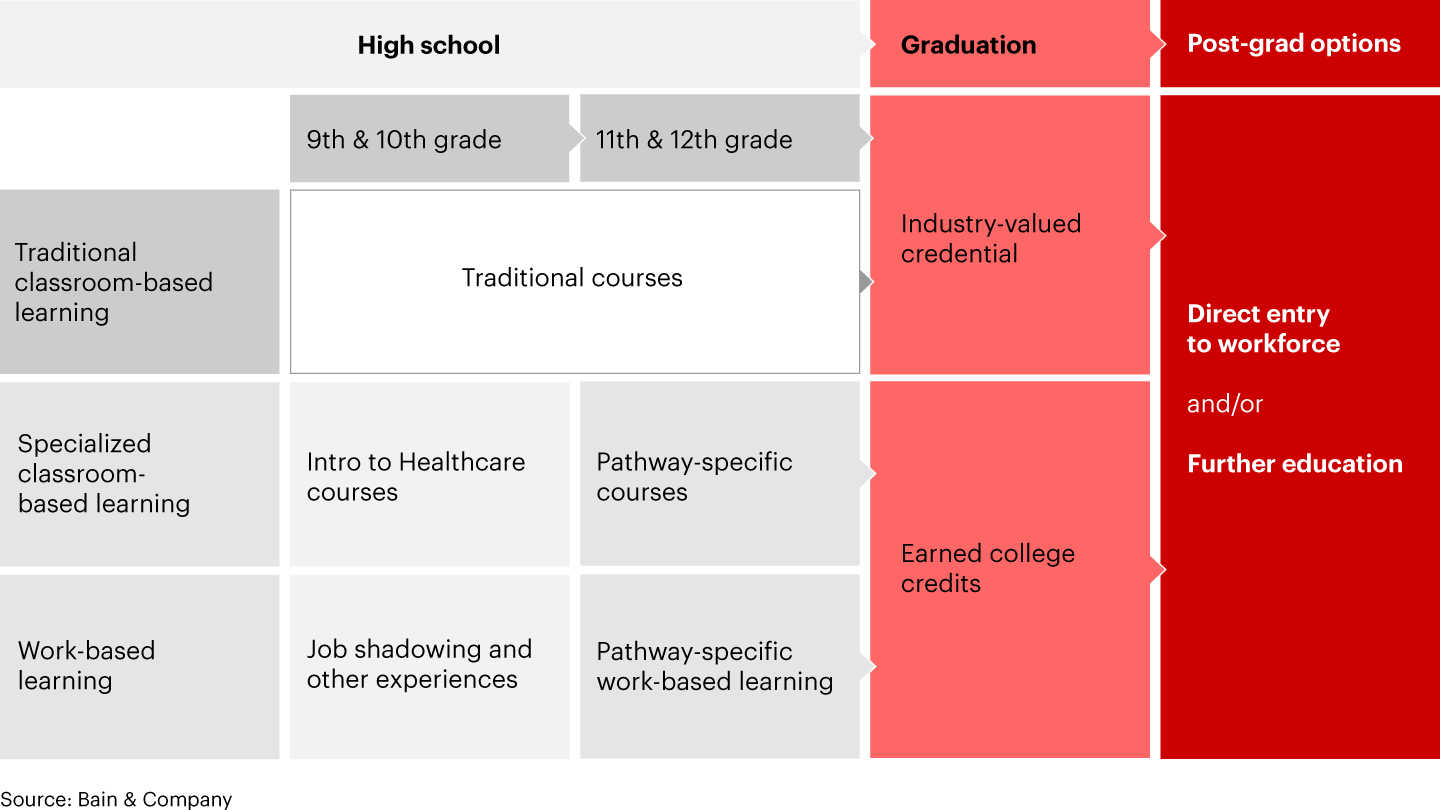Brief

At a Glance
- Health systems across the US are facing chronic talent shortages that drive up costs and make it challenging to deliver on their missions.
- Using a $250 million grant from Bloomberg Philanthropies, 10 of them are forging deep partnerships with local school districts to develop new high schools that offer students clear pathways to healthcare careers.
- What makes them work is a career-connected learning model designed to benefit both employers and students—one that spurs economic growth and provides students with multiple pathways to a promising career.
The US economy’s enduring mismatch between good, available jobs and strong candidates to fill them plays out daily at Houston’s Memorial Hermann Health System (MHHS).
Over the course of a year, MHHS could be looking to fill around 3,000 openings, many of them critical positions like nurse, surgical assistant, or radiologic technologist—attractive jobs that offer good wages and a clear path to a family-sustaining career.
Qualified candidates are chronically scarce, largely because the US education system isn’t turning out enough of them (see Figure 1). “We’re short of the people we need now and into the future,” said David Callender, MHHS president and chief executive. “The pipeline just isn’t big enough.”

Confronting the talent gap
With talent issues threatening their ability to meet the needs of their communities, MHHS and health systems in nine other US geographies are engaged in a foundational rethink of how employers and educators can work together to prepare young people for healthcare careers.
Sparked by $250 million in seed money from Bloomberg Philanthropies, these health systems have joined with local school districts to co-create a set of new (or newly reimagined) healthcare-focused high schools that offer students clear pathways to in-demand, well-paid healthcare careers. In addition to Houston, they are located in Boston, New York, Philadelphia, Charlotte and Durham, North Carolina, Dallas, and Nashville, as well as in rural Alabama and northeast Tennessee.
The schools build on the growing career-connected learning movement (CCL), which has been winning converts among educators and employers across the US. They are designed to combine classroom learning with on-the-job work experiences that include paid internships and mentoring at the healthcare systems.
This “study-and-work” approach turns out to be a better way to learn for many students than the traditional “study-then-work” model. Many find the opportunity to combine classroom learning with real-world work experience a better match for how they learn, allowing them to dream bigger and have a fair shot at achieving those dreams. The payoff for employers is a steady stream of young, motivated job candidates prepared to succeed in the jobs health systems most need to fill.
Market driven, student centered
Developing career pathways in high schools is a hot trend. What makes these 10 schools stand out is the depth of the partnerships forged between the employers, school districts, post-secondary institutions, and government officials behind them. Driving this close collaboration is a CCL model that is both market driven and student centered. That balance is critical. These new partnerships are neither corporate philanthropy nor vocational training. They are new-to-the-world schools designed to address the employer’s pressing need for talent, while offering students a great education and agency via multiple pathways to a good job, continued education, and a promising career (see Figure 2).

Leaders hoping to develop such an innovative educational model need to design around four essential elements.
1. Focus on good jobs, not just any jobs
A CCL model with broad, scalable appeal has to focus on jobs that promise a family-sustaining career—not just any jobs. We define good jobs as those that pay a living wage, provide opportunities for upward progression, and aren’t at risk of obsolescence. Focusing on good jobs addresses the needs of employers and students alike. For health systems, jobs like registered nurse, clinical lab technician, or respiratory therapist are mission-critical functions essential for maintaining capacity levels and providing high-quality care at the heart of the system’s mission. For students with the right preparation, these jobs are accessible and attractive, and offer a path to economic self-sufficiency.
A good example is the nursing pathway at Health Education and Learning (HEAL) High School, which is part of the Aldine, Texas, school district and partnered with MHHS. It is designed as a launchpad for registered nursing positions at the health system, ranging from $71,000 to $135,000 in annual salary. Students in Boston taking the surgery pathway co-developed by Mass General Brigham (MGB) and Edward M. Kennedy (EMK) Academy for Health Careers qualify right away for a surgical technician role starting at $57,000 annually. The hospital operations pathway co-sponsored by Children’s Hospital of Philadelphia and nearby Mastery High School qualifies students for sterile processing tech jobs that start at more than $24 an hour.
2. Reimagine the high school experience
Making these pathways work for students requires rethinking their journey through high school. Pathways combine classroom study with clinical work experiences in a program that is hands on and motivational for students. Critically, the resulting school experience isn’t somehow “less than” a traditional college prep pathway—students still meet all requirements in math, English, and history. But in addition to completing a college-prep curriculum, students in these programs receive industry-recognized credentials in their given area of focus while earning college-level credits toward a next-level degree (see Figure 3).

Boston’s EMK, for instance, offers ninth- and tenth-grade students the chance to gain hands-on exposure to a variety of disciplines at MGB before choosing a specific pathway. Those who choose nursing then go on to take Patient Care Technician I and II courses during Grades 11 and 12, alongside college-level courses such as anatomy, physiology, or Introduction to Psychology.
At the same time, nursing students intern on an MGB hospital floor or at a long-term care facility, supporting acting nurses under watchful supervision of a clinical preceptor—a trained clinician-turned-coach. These experiences earn students like Salma Sharif a certified nursing assistant (CNA) credential upon graduation, while opening their eyes to a world of possibilities. Sharif, who graduates this year, says the pathway “made me realize there are so many people in healthcare that are so supportive and willing to mentor me.” Classroom learning is one thing, but the real-life clinical experience “really motivates you to actually pursue (a career in healthcare).”
3. Create student choice
The intent of CCL pathways is to offer an alternative to the near-singular focus most high schools place on moving directly into full-time attendance at a four-year college—an emphasis that simply isn’t working for too many young people. The most effective pathways offer students the choice of moving into a job that pays right away or to continue their education in the way that best suits their needs. Often, this means mixing work and post-secondary education, an approach that can make study more affordable and impactful, while making work progressively more fulfilling and lucrative.
In 10th grade at EMK, Sharif had an anesthesia tech support internship that put her in the operating room with patients and sparked her interest in surgery. She did job shadowing in departments throughout MGH and developed a strong interest in neurology. Staffed in the Alzheimer’s and dementia unit, she met a woman whose battle with memory issues fascinated her and left her wanting to understand more about the disease and how she could help. Now Sharif is aiming for a neurology-related internship at MGB after she graduates, and her goal is to go on to earn an undergraduate degree in neurology.
4. Deliver economic benefits for employers
The healthcare systems attracted to these partnerships are seeking a return on their investment and long-term sustainability. They each have meaningful skin in the game and a commitment to develop a new talent pool excited to pursue career opportunities in their system. They are invested in making the partnership pay off.
Improving education, hiring locally, and making a meaningful contribution to workforce development are all consistent with a health system’s community mission. But a market-driven model also has to address critical business and quality-of-care objectives by reducing HR-related costs and boosting capacity for revenue-generating procedures.
Children’s Hospital of Philadelphia, for instance, has identified several metrics that contribute to the return on investment (ROI) from its partnership with Mastery High School. One of them is job churn: Reducing turnover on just 100 jobs saves $4 million in training and recruitment costs. MHHS in Houston likewise projects that reducing turnover 3% will save $3 million.
Boston’s MGB developed a sophisticated ROI model that quantified the system’s proposed commitments to the project against a range of potential benefits, pathway by pathway. It quantified staff time, access to hospital space, direct financial contributions to student post-secondary tuition, etc. Anticipated returns came largely from avoiding the cost of premium-price temporary staffing, reduced training costs, and less turnover. MGB modeled a range of financial scenarios, assuming different levels of temporary labor costs, and found that even in the most conservative scenario, the program yielded more than sufficient returns. That led the finance team to sign off on the investment and get fully behind the effort.
Catalyst required
The collaboration driving these 10 initiatives didn’t emerge in a vacuum. Career-connected learning is a compelling idea: an innovative version of high school that provides students with a better education and employers with a stronger workforce. But it requires multiple parties to come together in a way they normally don’t. The clear catalyst was Bloomberg’s $250 million investment, which brought all actors to the table with the shared objective of proving out the benefits of the model and making it work long term.
Critically, the money was contingent on the healthcare systems and school districts partnering as equals to co-develop and co-lead a solution. That required identifying in-demand good jobs, deciding on a set of initial pathways, and then co-designing the student experience in each pathway while codifying the resources, staff, and work opportunities to which the health system would commit. It also required clear buy-in and sponsorship from C-suite executives at the health system and school district leadership.
The opportunity Bloomberg catalyzed, however, is far greater than these 10 new partnerships. It will provide inspiration and a shining example of what’s possible through career-connected learning—within and beyond healthcare—for other communities and employers looking to build a better version of high school for their students and a stronger workforce for employers. The success of these new schools—and their deep employer and post-secondary partnerships—will make the benefits more certain and the roadmap more clear.
The opportunity is compelling, and those leading the charge are brimming with enthusiasm for what they will accomplish. “It's the right thing to do for patients, for our communities, for our children, for our system, for our state,” says Anne Klibanski, MGB president and CEO. “This will dramatically enhance our ability to train, educate, and diversify the next generation of healthcare professionals.”


